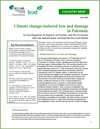-
Measuring Poverty From Space, and a Loss and Damage Strategy for Pakistan
September 15, 2016 By Anam Ahmed Accurate measurements of wealth are useful for developing more targeted and effective poverty reduction programs. Unfortunately, such metrics are few and far between, as data on economic livelihoods tends to be expensive to obtain, and once collected, is often unreliable. In a paper published in Science, Neal Jean, Marshall Burke, Michael Xie, Matthew Davis, David Lobell, and Stefano Ermon demonstrate how high-resolution satellite imagery can make predictions about the spatial distribution of wealth in five African nations. In doing so, they build on the growing body of literature that utilizes NASA’s nighttime images of lights visible from space as a measure of economic growth in lieu of traditional GDP metrics. The authors apply machine learning to combine data from daytime and nighttime satellite images to generate a measure of consumption and assets across Nigeria, Tanzania, Uganda, Malawi, and Rwanda. While some say their model may not be accurate enough for policy purposes, it relies solely on only publicly available data, which the authors suggest may allow for the inexpensive production of “granular data on other socioeconomic outcomes of interest to the international community, such as the large set of indicators proposed for the United Nations Sustainable Development Goals.”
Accurate measurements of wealth are useful for developing more targeted and effective poverty reduction programs. Unfortunately, such metrics are few and far between, as data on economic livelihoods tends to be expensive to obtain, and once collected, is often unreliable. In a paper published in Science, Neal Jean, Marshall Burke, Michael Xie, Matthew Davis, David Lobell, and Stefano Ermon demonstrate how high-resolution satellite imagery can make predictions about the spatial distribution of wealth in five African nations. In doing so, they build on the growing body of literature that utilizes NASA’s nighttime images of lights visible from space as a measure of economic growth in lieu of traditional GDP metrics. The authors apply machine learning to combine data from daytime and nighttime satellite images to generate a measure of consumption and assets across Nigeria, Tanzania, Uganda, Malawi, and Rwanda. While some say their model may not be accurate enough for policy purposes, it relies solely on only publicly available data, which the authors suggest may allow for the inexpensive production of “granular data on other socioeconomic outcomes of interest to the international community, such as the large set of indicators proposed for the United Nations Sustainable Development Goals.” Despite being a marginal contributor to global greenhouse gas emissions, Pakistan ranks among the countries suffering most from the impacts of climate change. As temperatures rise, increased flooding is a major risk due to its location within the Indus River Valley, and an estimated 50 percent of its population is vulnerable to the adverse impacts of climate-related events. In a recent policy brief published by the International Center for Climate Change and Development, Hina Lotia, Basharat Saeed, and Areej Riaz recommend an approach to building climate resilience in Pakistan that combines disaster risk reduction and adaptation with efforts to track loss and damage. With improved disaster-preparedness and climate adaptation techniques, the amount incurred can be greatly reduced, but given Pakistan’s vulnerability, loss and damage remains inevitable. They suggest mainstreaming loss and damage into public policy to help the country cope. “A realm exists beyond hopelessness and resignation to fate,” they write, “avenues exist for at least assuaging the impact of these costs on human systems and societies.” Attracting international support for addressing loss and damage will likely require the country to comply with the terms of the 2015 Paris Agreement and develop accurate risk monitoring mechanisms and impact measurement strategies, such as a national multi-hazard loss and damage database.
Despite being a marginal contributor to global greenhouse gas emissions, Pakistan ranks among the countries suffering most from the impacts of climate change. As temperatures rise, increased flooding is a major risk due to its location within the Indus River Valley, and an estimated 50 percent of its population is vulnerable to the adverse impacts of climate-related events. In a recent policy brief published by the International Center for Climate Change and Development, Hina Lotia, Basharat Saeed, and Areej Riaz recommend an approach to building climate resilience in Pakistan that combines disaster risk reduction and adaptation with efforts to track loss and damage. With improved disaster-preparedness and climate adaptation techniques, the amount incurred can be greatly reduced, but given Pakistan’s vulnerability, loss and damage remains inevitable. They suggest mainstreaming loss and damage into public policy to help the country cope. “A realm exists beyond hopelessness and resignation to fate,” they write, “avenues exist for at least assuaging the impact of these costs on human systems and societies.” Attracting international support for addressing loss and damage will likely require the country to comply with the terms of the 2015 Paris Agreement and develop accurate risk monitoring mechanisms and impact measurement strategies, such as a national multi-hazard loss and damage database.Sources: International Center for Climate Change and Development, Science.
Topics: adaptation, Africa, climate change, development, disaster relief, economics, environment, flooding, loss and damage, Malawi, Nigeria, Pakistan, poverty, Reading Radar, Rwanda, SDGs, Tanzania, Uganda
 A Publication of the Stimson Center.
A Publication of the Stimson Center.





